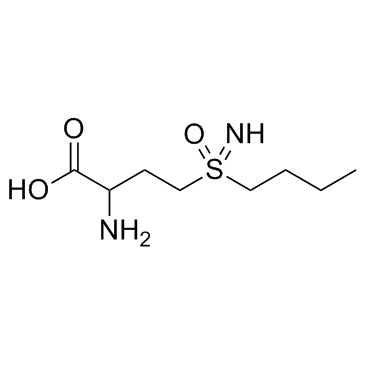Depletion of cellular glutathione modulates LIF-induced JAK1-STAT3 signaling in cardiac myocytes.
Mazen Kurdi, Vidhya Sivakumaran, Roy J Duhé, Miguel A Aon, Nazareno Paolocci, George W Booz
Index: Int. J. Biochem. Cell Biol. 44(12) , 2106-15, (2012)
Full Text: HTML
Abstract
Previously we reported that the sesquiterpene lactone parthenolide induces oxidative stress in cardiac myocytes, which blocks Janus kinase (JAK) activation by the interleukin 6 (IL-6)-type cytokines. One implication suggested by this finding is that IL-6 signaling is dependent upon cellular anti-oxidant defenses or redox status. Therefore, the present study was undertaken to directly test the hypothesis that JAK1 signaling by the IL-6-type cytokines in cardiac myocytes is impaired by glutathione (GSH) depletion, since this tripeptide is one of the major anti-oxidant molecules and redox-buffers in cells. Cardiac myocytes were pretreated for 6h with l-buthionine-sulfoximine (BSO) to inhibit GSH synthesis. After 24h, cells were dosed with the IL-6-like cytokine, leukemia inhibitory factor (LIF). BSO treatment decreased GSH levels and dose-dependently attenuated activation of JAK1, Signal Transducer and Activator of Transcription 3 (STAT3), and extracellular signal regulated kinases 1 and 2 (ERK1/2). Addition of glutathione monoethyl ester, which is cleaved intracellularly to GSH, prevented attenuation of LIF-induced JAK1 and STAT3 activation, as did the reductant N-acetyl-cysteine. Unexpectedly, LIF-induced STAT1 activation was unaffected by GSH depletion. Evidence was found that STAT3 is more resistant than STAT1 to intermolecular disulfide bond formation under oxidizing conditions and more likely to retain the monomeric form, suggesting that conformational differences explain the differential effect of GSH depletion on STAT1 and STAT3. Overall, our findings indicate that activation of both JAK1 and STAT3 is redox-sensitive and the character of IL-6 type cytokine signaling in cardiac myocytes is sensitive to changes in the cellular redox status. In cardiac myocytes, activation of STAT1 may be favored over STAT3 under oxidizing conditions due to GSH depletion and/or augmented reactive oxygen species production, such as in ischemia-reperfusion and heart failure.Copyright © 2012 Elsevier Ltd. All rights reserved.
Related Compounds
| Structure | Name/CAS No. | Molecular Formula | Articles |
|---|---|---|---|
 |
D,L-Buthionine-(S,R)-sulfoximine
CAS:5072-26-4 |
C8H18N2O3S |
|
Redox regulation of MMP-3/TIMP-1 ratio in intestinal myofibr...
2000-01-01 [Exp. Cell Res. 323(1) , 77-86, (2014)] |
|
Inhibition of glutathione synthesis distinctly alters mitoch...
2014-04-01 [Exp. Biol. Med. (Maywood.) 239(4) , 394-403, (2014)] |
|
Isoliquiritigenin attenuates oxidative hepatic damage induce...
2015-01-05 [Chem. Biol. Interact. 225 , 13-20, (2015)] |
|
Grape powder supplementation prevents oxidative stress-induc...
2013-06-01 [J. Nutr. 143(6) , 835-42, (2013)] |
|
Neurotoxicity of "ecstasy" and its metabolites in human dopa...
2013-02-04 [Toxicol. Lett. 216(2-3) , 159-70, (2013)] |